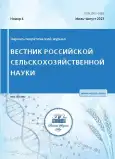Assessment of the phytosanitary state of agricultural seedings using agrobiotechnology
- Authors: Chuyan N.A1, Breskina G.M1
-
Affiliations:
- Federal State Budgetary Scientific Institution "Federal Agricultural Kursk Research Center"
- Issue: No 4 (2023)
- Pages: 29-35
- Section: Articles
- URL: https://journals.rcsi.science/2500-2082/article/view/141504
- DOI: https://doi.org/10.31857/2500-2082/2023/4/29-35
- EDN: https://elibrary.ru/DLKOZJ
- ID: 141504
Cite item
Full Text
Abstract
About the authors
N. A Chuyan
Federal State Budgetary Scientific Institution "Federal Agricultural Kursk Research Center"
Email: natalia-chuyan@yandex.ru
G. M Breskina
Federal State Budgetary Scientific Institution "Federal Agricultural Kursk Research Center"
References
- Бусыгин Е.И. Эффективность комплексного применения биологических и химических средств защиты растений // Защита и карантин растений. 2017. №3. С. 7-9.
- Высоцкая Е.А., Крекотень М.А. Оптимизация биоресурсного потенциала подсолнечника с использованием в технологии возделывания биологически активных препаратов // Вестник Воронежского государственного университета. 2017. №1. (52). С. 20-26.
- Защепкин Е.Е., Шутко А.П., Тутуржанс Л.В. Желтая пятнистость как составная часть патогенного комплекса озимой пшеницы в Центральном Предкавказье // Современные проблемы науки и образования. 2015. №2. С. 828-838.
- Зыков С.А. Биопрепараты в современном земледелии // АгроФорум. 2019. №3. С. 21-27.
- Койшыбаев М., Муминджаков Х. Методические указания по мониторингу болезней, вредителей и сорных растений на посевах зерновых культур. Анкара. 2016. 42 с.
- Мамсиров Н.И., Благополучная О.А., Мамсиров Н.А. Эффективность применения биопрепаратов при возделывании зерновых культур // Земледелие. 2014. № 5. С. 24-26.
- Методы учета структуры сорного компонента в агроценозах: учебное пособие / сост.: И.В. Фетюхин, А.П. Авдеенко, С.С. Авдеенко и др. Донской ГАУ, 2018. 76 с.
- Сабирова Т.П. Влияние биопрепаратов на продуктивность сельскохозяйственных культур // Вестник АПК Верхневолжья. 2018. №3 (43). С. 18-22.
- Санин С.С. Проблемы фитосанитарии России на современном этапе // Известия Тимирязевской сельскохозяйственной академии. 2016. №6. С. 45-53.
- Сырмолот О.В., Байделюк Е.С., Кочева Н.С. Применение биопрепаратов и стимуляторов роста при возделывании сои в Приморском крае// Достижения науки и техники АПК. 2020. Т.34. №8. С. 70-74.
- Торопова Е.Ю., Захаров А.Ф. Предпосевная подготовка семян яровой пшеницы в условиях ресурсосберегающих технологий // Защита и карантин растений. 2017. №3. С. 28-32.
- Щучка Р.В. Особенности влияния биопрепаратов и стимуляторов роста и способа их применения на урожай и качество семян сои: монография. Елец: Елецкий государственный университет им. И.А. Бунина, 2016. 90 с.
- Ямалиева А.М., Апаева Н.Н. Роль биопрепаратов в улучшении фитосанитарного состояния посевов и повышении урожайности зерновых культур // Вестник Марийского государственного университета, серия "Сельскохозяйственные науки. Экономические науки". 2020. Т. 6. №4. С. 450 - 458.
- Jurosek P. Tiedemann A. Linking plant disease models to climate change scenarios to project future risks of crop diseases // Journal of Plant Diseases and Protection. 2015. No. 122 (1). P. 3-15.
Supplementary files










